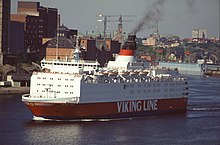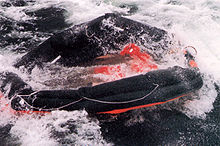MS Estonia
 Scale model of MS Estonia
| |
| History | |
|---|---|
| Name |
|
| Owner |
|
| Operator |
|
| Port of registry | |
| Ordered | 11 September 1979 |
| Builder | Meyer Werft, Papenburg, West Germany |
| Yard number | 590 |
| Laid down | 18 October 1979 |
| Launched | 26 April 1980 |
| Acquired | 29 June 1980 |
| In service | 5 July 1980 |
| Identification |
|
| Fate | Capsized and sank on 28 September 1994 |
| General characteristics | |
| Type | Cruiseferry |
| Tonnage | |
| Length |
|
| Beam | 24.21 m (79 ft 5 in) |
| Draught | 5.60 m (18 ft 4 in) |
| Decks | 9 |
| Ice class | 1 A |
| Installed power |
|
| Speed | 21.1 knots (39.1 km/h; 24.3 mph) |
| Capacity |
|
MS Estonia was a cruiseferry built in 1980 at the West German shipyard Meyer Werft in Papenburg. In 1993, she was sold to Nordström & Thulin for use on Estline's Tallinn–Stockholm route. The ship's sinking on 28 September 1994, in the Baltic Sea between Sweden, Åland, Finland and Estonia, was one of the worst maritime disasters of the 20th century, claiming 852 lives.
The official report concluded that the bow door had separated from the vessel, pulling the ramp ajar. The ship was already listing because of poor cargo distribution, and the list increased rapidly, flooding the decks and the cabins. Shortly, power failed altogether, inhibiting search and rescue, and a full-scale emergency was not declared for 90 minutes. Of the 989 on board, 138 were rescued. The report criticised the passive attitude of the crew, failing to notice that water was entering the vehicle deck, delaying the alarm, and providing minimal guidance from the bridge.
Coordinates: 59°23′0″N 21°40′0″E / 59.38333°N 21.66667°E
Construction[]
The ship was originally ordered from Meyer Werft by a Norwegian shipping company led by with intended traffic between Norway and Germany. At the last moment, the company withdrew their order and the contract went to Rederi Ab Sally, one of the partners in the Viking Line consortium (SF Line, another partner in Viking Line, had also been interested in the ship).[3]
Originally the ship was conceived as a sister ship to Diana II, built in 1979 by the same shipyard for Rederi AB Slite, the third partner in Viking Line. When Sally took over the construction contract, the ship was lengthened from the original length of approximately 137 metres (449 ft) to approximately 155 metres (509 ft) and the superstructure of the ship was largely redesigned.[3]
Meyer Werft had constructed a large number of ships for various Viking Line partner companies during the 1970s. The construction of the ship's bow consisted of an upwards-opening visor and a car ramp that was placed inside the visor when it was closed. An identical bow construction had also been used in Diana II.[JAIC 1]
Service history[]
This section needs additional citations for verification. (October 2020) |
Estonia previously sailed as Viking Sally (1980–1990), Silja Star (1990–1991), and Wasa King (1991–1993).
Viking Line[]

On 29 June 1980, Viking Sally was delivered to Rederi Ab Sally, Finland and was put into service on the route between Turku, Mariehamn and Stockholm[3][4] (during summer 1982 on the Naantali–Mariehamn–Kapellskär route).[5] She was the largest ship to serve on that route at the time. As with many ships, Viking Sally suffered some mishaps during her Viking Line service, being grounded in the Åland Archipelago in May 1984 and suffering some propeller problems in April of the following year. In 1985 she was also rebuilt with a "duck tail".[3][4] In 1986, a passenger was murdered on board. In 1987, another murder and attempted murder took place. Rederi Ab Sally had been experiencing financial difficulties for most of the 1980s. In late 1987, Effoa and Johnson Line, the owners of Viking Line's main rivals Silja Line, bought Sally.[6] As a result of this, SF Line and Rederi AB Slite forced Sally to withdraw from Viking Line.[3][4][6] Viking Sally was chartered to Rederi AB Slite to continue on her current traffic for the next three years.[3][4][6]
EffJohn[]
When her charter ended in April 1990, Viking Sally had an unusual change of service. She was painted in Silja Line's colours, renamed Silja Star and placed on the same route that she had plied for Viking Line: Turku–Mariehamn–Stockholm.[3][4] The reason for this was that Silja's new ship for Helsinki–Stockholm service was built behind schedule and one of the Turku–Stockholm ships, Wellamo, was transferred to that route until the new ship was complete in November 1990.[7] Also in 1990 Effoa, Johnson Line and Rederi Ab Sally merged into .
The following spring Silja Star began her service with Wasa Line, another company owned by EffJohn. Her name was changed to Wasa King and she served on routes connecting Vaasa, Finland to Umeå and Sundsvall in Sweden.[3][4] It has been reported that the Wasa King was widely considered to be the best behaving ship in rough weather to have sailed from Vaasa.
Estline[]


In January 1993, at the same time when EffJohn decided to merge Wasa Line's operations into Silja Line, Wasa King was sold to Nordström & Thulin for use on Estline's Tallinn–Stockholm traffic under the name Estonia. The actual ownership of the ship was rather complex, in order for Nordström & Thulin to get a loan to buy the ship. Although Nordström & Thulin was the company which bought the ship, her registered owner was Estline Marine Co Ltd, Nicosia, Cyprus, which chartered the ship to E.Liini A/S, Tallinn, Estonia (daughter company of Nordström & Thulin and ESCO), which in turn chartered the ship to Estline AB. As a result, the ship was actually registered in both Cyprus and Estonia.[3][4]
As the largest Estonian-owned ship of the time, the Estonia symbolized the independence that Estonia regained after the collapse of the Soviet Union.[8]
Decks and facilities[]


The MS Estonia consisted of 11 decks, counting from the lowest (0) to the highest (10). Passenger facilities were located on decks 6, 5, 4, and 1, while the crew members occupied decks 8 and 7. Decks 2 and 3 were dedicated to cargo.
As Viking Sally[]
| 9 | Bridge, sundeck[9] |
| 8 | Crew cabins, sundeck[10][9] |
| 7 | Crew cabins & facilities, sundeck[11] |
| 6 | Restaurant deck – Buffet dining room, à la carte restaurant, bar, outside and inside cabins[12] |
| 5 | Entrance & cafeteria deck – Tax-free shops, cafeteria, snack bar, discotheque, air seats, children's playroom, outside and inside cabins[9][13] |
| 4 | Conference deck – Conference rooms, nightclub, cinema, inside and outside cabins[13] |
| 3 | Car platform[14] |
| 2 | Car deck[14] |
| 1 | Inside cabins,[12] engine room[11] |
| 0 | Sauna, swimming pool, conference rooms[12] |
Sinking[]
| Nationalities | Deaths | Survivors | Total |
|---|---|---|---|
| 501 | 51 | 552 | |
| 285 | 62 | 347 | |
| 23 | 6 | 29 | |
| 11 | 4 | 15 | |
| 10 | 3 | 13 | |
| 6 | 3 | 9 | |
| 5 | 3 | 8 | |
| 5 | 1 | 6 | |
| 3 | 1 | 4 | |
| 2 | 0 | 2 | |
| 1 | 1 | 2 | |
| 1 | 1 | 2 | |
| 1 | 1 | 2 | |
| 1 | 0 | 1 | |
| 1 | 0 | 1 | |
| 1 | 0 | 1 | |
| 1 | 0 | 1 | |
| Total | 852 | 137 | 989 |

The Estonia disaster occurred on Wednesday, 28 September 1994, between about 00:55 and 01:50 (UTC+2) as the ship was crossing the Baltic Sea, en route from Tallinn, Estonia, to Stockholm, Sweden.[15][16] Estonia departed slightly behind schedule at 19:15 on 27 September and had been expected in Stockholm the next morning at about 09:00. She was carrying 989 people: 803 passengers and 186 crew.[17][JAIC 2] Most of the passengers were Swedish, although some were of Estonian origin, while most of the crew members were Estonian. The ship was fully loaded, and was listing slightly to starboard (to the right looking from the ship in the direction of its travel) because of poor cargo distribution.[18][19] There is a memorial for the event in Tallinn.[20]
See also[]
- List of RORO vessel accidents
- List of accidents and disasters by death toll
- List of shipwrecks in 1994
- Sinking of the MS Estonia
References[]
- ^ "M/F Estonia". The ferry site. Retrieved 21 October 2021.
- ^ a b Final report on the capsizing on 28 September 1994 in the Baltic Sea of the Ro-Ro passenger vessel MN Estonia, Chapter 3: The vessel. The Joint Accident Investigation Commission of Estonia, Finland and Sweden, December 1997.
- ^ a b c d e f g h i "Wasa King" (in Swedish). Vasabåtarna.se. Retrieved 29 October 2007.
- ^ a b c d e f g "M/S Viking Sally" (in Swedish). Fakta om Fartyg. Retrieved 29 October 2007.
- ^ "Viking Sally schedules 1980–1990" (in Finnish). FCBS Forum. Retrieved 29 October 2007.
- ^ a b c "Simplon Postcards: Viking Sally – Wasa King – Silja Star – Estonia". Retrieved 28 September 2014.
- ^ "MS Wellamo (1986)" (in Swedish). Fakta om Fartyg. Retrieved 29 October 2007.
- ^ "The Sinking of the Estonia." Surviving Disaster.[1] BBC.[dead link]
- ^ a b c "Viking Sally deck plan". Viking Line brochure (in Finnish, Swedish, and English). Vasabåtarna.se. Retrieved 20 December 2008.
- ^ "General arrangement". www.estoniaferrydisaster.net. Retrieved 21 June 2021.
- ^ a b "Viking Sally General Arrangement plan". Vasabåtarna.se. Retrieved 20 December 2008.
- ^ a b c "Viking Sally Restaurant deck 6 plan". Viking Line brochure (in Swedish and Finnish). Vasabåtarna.se. Retrieved 20 December 2008.
- ^ a b "Viking Sally Conference deck 4 plan". Viking Line brochure (in Swedish and Finnish). Vasabåtarna.se. Retrieved 20 December 2008.
- ^ a b "Viking Sally cutaway". Viking Line brochure (in Swedish, Finnish, and English). Vasabåtarna.se. Retrieved 20 December 2008.
- ^ "MV ESTONIA (Accident Investigation Commission (JAIC) Final Report)". Onnettomuustutkintakeskus (in Kinyarwanda). 15 January 2021. Retrieved 21 October 2021.
- ^ "The ESTONIA accident 1994". SHK Statens Haverikommission (Swedish Accident Investigation Board). Retrieved 21 October 2021.
- ^ Whittingham, The Blame Machine, p. 137
- ^ Whittingham, The Blame Machine, p. 138
- ^ "M/S Estonia emergency traffic". windytan.com/Estonia. Retrieved 21 October 2021.
- ^ "Memorial to the Estonia in Tallinn". Sites of Memory: Historical Markers, Memorials, Monuments, and Cemeteries. Retrieved 21 October 2021.
General[]
- Whittingham, Robert B. (2004). "Design errors". The Blame Machine: why human error causes accidents. Oxford: Elsevier Butterworth-Heinemann. ISBN 0-7506-5510-0.
- "Final report on the MV ESTONIA disaster of 28 September 1994". Helsinki: Joint Accident Investigation Commission. 1997. Archived from the original on 2 June 2001. Cite journal requires
|journal=(help)CS1 maint: unfit URL (link)
- ^ "Chapter 11.3 – The DIANA II incident". Archived from the original on 2 June 2001. Cite journal requires
|journal=(help) - ^ "Chapter 7.6 – The human outcome". Archived from the original on 2 June 2001. Cite journal requires
|journal=(help)
External links[]
| Wikimedia Commons has media related to IMO 7921033. |
- MS Estonia
- Ferries of Estonia
- Cruiseferries
- Ships built in Papenburg
- 1980 ships
